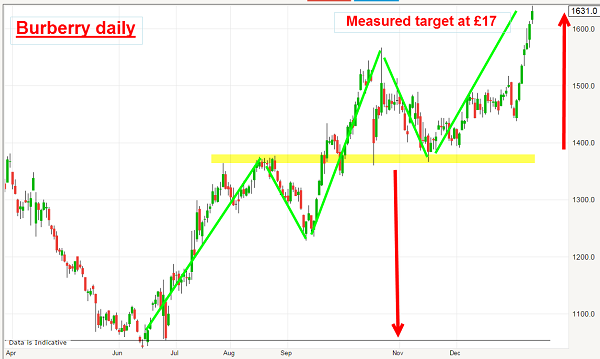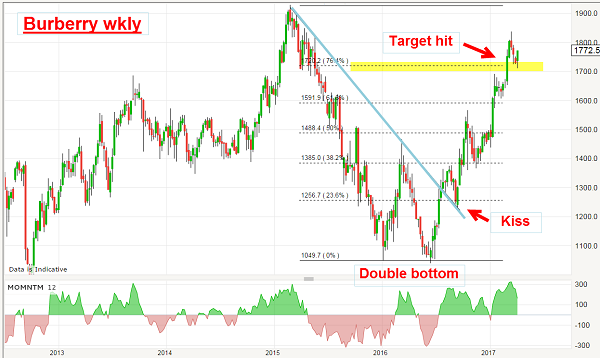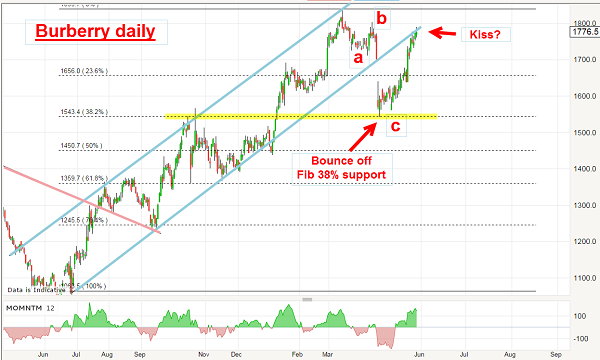Chart of the week: The right time to sell
30th May 2017 12:11
by John Burford from interactive investor
Share on
Burberry has given me a textbook trade
I last covered this share on April 10 and noted that the bull phase I had forecast previously was still in force and my first target at £17 had been achieved. This is where I decided to take some profits off the table from last year's entries around the £12 area.
Let me explain my conservative strategy towards handling targets because most traders don't have one (but really do need one!). I believe that having at the ready a plan of what you will do when a serious target is reached is a key component of a winning trading system.
Sadly, most traders focus mostly only on their market analysis for picking trade entries and direction and little on their exit strategies. This is a universal human trait. Famously, politicians are leaders in this field as is evidenced by their expert engagement in recent Middle East wars, but totally neglecting their exit strategies that have led to such chaos there. But I digress.
Not having a disciplined exit strategy for your trades also usually leads to chaos. With no exit strategy, and if the market retraces after hitting a target and you see your lovely hard-won profits evaporate, that is very disheartening. Now you are anxious and regret not acting when you had the chance to maximise your gains. Poor decisions usually follow.
Before I place a trade, I like to establish at least one target area where I usually take partial profits and leave the remainder working in case there is more. My targets are not some vague fingers-crossed guestimate that is the method of choice of some pundits. Ideally, it is the result of examining the Fibonacci levels, or a tramline area or an Elliott wave forecast, or preferably a combination of all three.
And the example of is a good one. This is the chart I used to pinpoint one major target back in January:

I noted the five-wave continuation zig-zag pattern (marked in green) and I knew that this pattern usually lies at least half-way along a major wave. That gave me a measured target at least in the £17 area.
In addition, I noted that the £17 area was around the Fibonacci 78% retrace of the big wave down off the 2015 high at around the £19 level:

So I had two independent methods to give me identical target areas - at around £17. And when the market rose to that level, I decided to take partial profits of £5 a share (a 40% gain).
But I still had part of my original position working. The worst case scenario would be that the market would fall back to my entry at £12 where I already planned to exit for a wash trade. My stop loss was already in the market. And if that occurred, my net result would be a £5 profit on part of my trade - a winning trade!
But if the market continues trading above my entry price, I have the luxury of being able to sit through set-backs and perhaps look forward to an even bigger profit. Here is the updated chart:

I had worked out that the £17 area was formidable resistance - and so it is proving with the market swinging on each side of that level. My lower tramline was broken on April 19 on results, but found suport right on the Fibonacci 38% retrace level at £15.50.
That was a very sharp break and, because I still retained part long position, I had the luxury of being able to wait and see if the market could recover. Remember, my worst case scenario was a fall back to the £12 level - and that was a long way down.
In fact, the market did recover in May and has just rallied to kiss the underside of the lower tramline at £17.80.
This is decision time! Because odds now favour a move down off that kiss, I am taking remaining profits here for a very satisfactory trade. And even if the market powers up from here, I am not concerned because I strictly followed my trading rules with little impact on my already-low stress levels! It's all about discipline.
If I have mis-judged the rally, I will not complain as I have banked a 40%-plus profit (much higher with using spread betting!).
Of course, this is just one exit strategy, but its simplicy is such that I can recommend it to investors and traders alike.
If you would like to follow my trades in real time, visit my website at tramlinetraders.com.
These articles are provided for information purposes only. Occasionally, an opinion about whether to buy or sell a specific investment may be provided by third parties. The content is not intended to be a personal recommendation to buy or sell any financial instrument or product, or to adopt any investment strategy as it is not provided based on an assessment of your investing knowledge and experience, your financial situation or your investment objectives. The value of your investments, and the income derived from them, may go down as well as up. You may not get back all the money that you invest. The investments referred to in this article may not be suitable for all investors, and if in doubt, an investor should seek advice from a qualified investment adviser.
Full performance can be found on the company or index summary page on the interactive investor website. Simply click on the company's or index name highlighted in the article.
Disclosure
We use a combination of fundamental and technical analysis in forming our view as to the valuation and prospects of an investment. Where relevant we have set out those particular matters we think are important in the above article, but further detail can be found here.
Please note that our article on this investment should not be considered to be a regular publication.
Details of all recommendations issued by ii during the previous 12-month period can be found here.
ii adheres to a strict code of conduct. Contributors may hold shares or have other interests in companies included in these portfolios, which could create a conflict of interests. Contributors intending to write about any financial instruments in which they have an interest are required to disclose such interest to ii and in the article itself. ii will at all times consider whether such interest impairs the objectivity of the recommendation.
In addition, individuals involved in the production of investment articles are subject to a personal account dealing restriction, which prevents them from placing a transaction in the specified instrument(s) for a period before and for five working days after such publication. This is to avoid personal interests conflicting with the interests of the recipients of those investment articles.